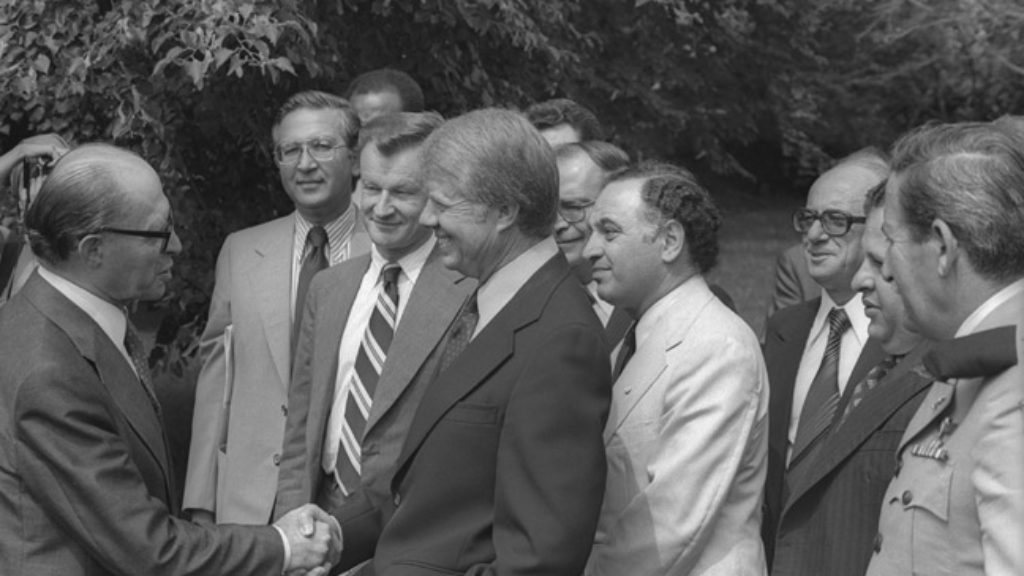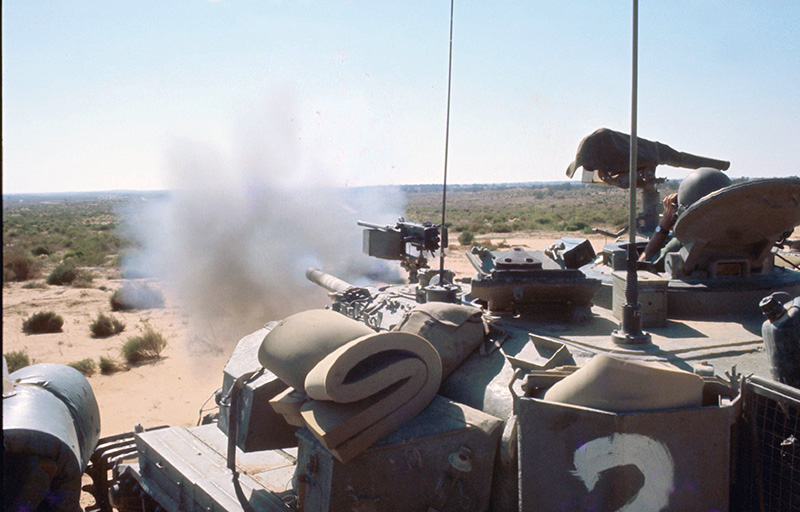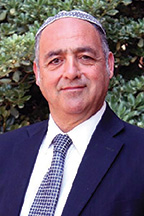Readjusting Sights
On the morning of October 7, a young tank crewman named Roi rushed to join his company on the Gaza border, but the unit wasn’t there and the base was in disarray—corpses along the road, burned-out buildings, no sign of the senior command. This was Camp Yiftach, named for the biblical warrior, the wild son of a prostitute called back to his tribe to save Israel from the Ammonites. The Hamas men were still butchering civilians nearby, though the scale of it wasn’t yet clear. “We reached the guard-post by the gate in the evening and tried to find gear,” Roi told a reporter from an army website, where I read this story in the second week of the war, “but everything was ruined and covered in blood.” He found three functional crewmates and the only operational tank in the base and rumbled out to fight, navigating with a paper map “like in books from the old days.”
Roi’s story seemed less like a news report than a scene from Adjusting Sights. Haim Sabato’s war memoir opens almost exactly fifty years earlier. The Yom Kippur fast has ended on October 6, 1973, and Israel is reeling from a surprise attack on two fronts that afternoon. The author, a yeshiva student not long out of the Armored Corps, an Israeli born in Egypt to a line of rabbis from Aleppo, leaves home to join his unit in the north. When he reaches the base, also called Camp Yiftach, men are frantically outfitting tanks, and improvised crews are setting off up the road into combat on the Golan Heights. The Syrians have overrun the border and are pushing toward the Sea of Galilee. The army seems on the verge of collapse.
“We had to work on the tanks in the dark,” Sabato writes in Adjusting Sights. “Everyone was shouting at once. ‘Take these shells . . . Go bring some rifles . . . Don’t forget binoculars. . . . We’re short a crew member. . . .’ I crawled into the gunner’s compartment to check the sights. We had an instructor in our tank course who always said, ‘The first thing a gunner does is adjust his sights. You can’t hit a thing before you do.’ But now an officer shouts that there isn’t time: ‘Don’t you understand that every second counts?’” The narrator argues to no avail. “I replaced the firing pin, climbed into the gunner’s compartment, and drove off to the war with unadjusted sights like everyone else.”
The Hebrew phrase “adjusting sights,” te’um kavanot, has depth absent in the English. The first word means to “align” or “match,” and the second means “sights” but also “intentions,” as in the intentions with which one prays. Sabato spends the war trying to align his intentions with passages, prayers, and stories from the Jewish tradition.
In the months leading up to the outbreak of the current war on October 7, Israel was commemorating the fiftieth anniversary of the Yom Kippur War, the country’s darkest moment until now. In 1973, military intelligence missed the signs of an impending attack, the government’s basic assumptions turned out to be wrong, and more than 2,600 Israeli soldiers were killed. After the Yom Kippur War, the country began to lose faith in the old Labor Zionist leadership, and our politics and society changed permanently. Countless books have been written about that war (I wrote one myself), and more come out every year.
It’s a strange fact that a bookish country defined by wars has produced reams of analysis, military history, and recollections by generals—but almost no war memoirs of literary value. I’m not sure why. When Adjusting Sights came out in 1999, going on to win Israel’s highest literary prize and to earn a place in the Hebrew canon, it was unique for the way it presented the war through the eyes of a tank gunner who spoke from the army’s lowest ranks, from the immigrant neighborhood in Jerusalem where he lived, and from the study hall of the yeshiva.
The author wasn’t a creature of the literary scene or the world of secular culture in Tel Aviv, but a rabbi, a stranger among the people who produce most of Israel’s writing. And yet Sabato’s voice was Israeli and couldn’t be from anywhere else: in Adjusting Sights it’s easy to see the presence of ancient Jewish texts and of the Hebrew literary giant S.Y. Agnon, but international influences are all but impossible to detect. It’s not quite right to say that the book mixes the sacred and the profane. Sabato doesn’t seem to think any of what he describes is profane. “So highly strung were our souls in those days,” he writes of the war, “that whatever touched them made them tremble.”
Sabato’s book was published a quarter-century after the events in question, in keeping with the rule that lasting works by soldiers are almost always written many years after they come home. Erich Maria Remarque’s All Quiet on the Western Front, for example, came out more than a decade after World War I ended, in 1929, the same year as Robert Graves’s famous Good-Bye to All That. Tim O’Brien’s masterpiece The Things They Carried appeared in 1990, two decades after the author served in Vietnam. And the best memoir by an Israeli soldier in any war is Yoram Kaniuk’s 1948, which came out in 2010—a lag of more than sixty years.
Sabato sat down to write precisely at the midpoint between his war and the one we’re in now. It wasn’t a matter of reaching back and remembering, he told me when we spoke in the library at the yeshiva he runs in Ma’ale Adumim, outside Jerusalem. For him and his friends, the battle never really ended. “Writing or no writing,” he said, they’re still in the quarry at Nafakh on the Golan Heights, surrounded by Syrians, driving tanks whose engines constantly stall and whose cannons have unadjusted sights. After a nighttime collision with an embankment, one tank’s cannon fills with soil and blows up when the crew tries to fire. A childhood friend, the driver of another tank, vanishes. It was all there when Sabato sat down at his computer. He wrote the story overnight, he said, typing in a trance until his wife got concerned and made him stop. The final version, he said, was virtually untouched by his editor. It was published as he wrote it that night.
Sabato’s book exists in a world not of history but of memory. It’s October 1973—but here’s the Maharal of Prague from the sixteenth century and Nakdimon Ben-Gurion negotiating with the Roman procurator in Jerusalem and, in the space of two pages, King Saul, the Philistines, the Crusaders, and Field Marshal Rommel. In the book’s opening paragraphs, we meet both Rabbi Akavia ben Mahalalel of the first or second century CE and the disciples of the Amshinover Rebbe, whom the author sees blessing the moon in gowns that look like shrouds as the war breaks out in 1973.
Adjusting Sights moves in and out of Jewish texts so frequently that it’s sometimes hard to remember when the author is speaking and when it’s the sages. The standard orders of a tank commander—“Crew, mount! Driver, sharp left! Gunner, hollow charge, two thousand meters, fire!”—are mixed up with orders of a completely different kind: “Gunner, pray!”
True to the tradition of the Talmud, where rabbis argue with each other even if they live in different centuries, the author isn’t interested in chronology. Within three pages of the beginning of the book, the war has ended. Then we’re in the battle again, then in Sabato’s childhood, then in the Mishnah, then back in the quarry on the Golan Heights as a burning soldier rolls on the ground and the author sprints for cover.
When we spoke, Sabato said, “There isn’t a chronological order in the story but an emotional order.” His life and education flashed before him in battle, so that’s the way he wrote it. It was all happening at the same time—his childhood, the war, the world after the war, the prophets, and the Talmud: “For twenty-five years we lived with it, all of us from the unit, but we couldn’t talk about it, because no one would believe us. I think the people of [Kibbutz] Be’eri feel alone in the same way. People who haven’t been through something like this can’t understand it. They think you’re exaggerating or don’t believe you at all.”
Adjusting Sights was translated into English by Hillel Halkin. When I reached him at his home in Zikhron Yaakov, we talked about war before we talked about Sabato’s novel. It’s interesting to compare that war and this one, Halkin said. All in all, he thinks the present is worse. The dead of Yom Kippur were soldiers; this time it’s mostly civilians. Next to the atrocities committed in Israeli living rooms and kitchens in 2023, the battles of 1973 seem almost innocent. And though the first week of the Yom Kippur War was frightening for Israelis at home, Halkin remembered, after that it was clear the country would pull through and that the home front was safe. Today, when much of the social solidarity and political unity of those days has eroded, the entire country is gripped by a kind of existential dread. “No military defeat is possible,” Halkin said, “but a psychological and emotional one is.”
The translator remembered a minor figure in Sabato’s book, a yeshiva student who appears late in the story, when the fighting is mostly over but the men are still deep in Syrian territory. This soldier had escaped a burning tank with his crewmates, making it to the safety of a cave, where they hid until a Syrian soldier threw in a grenade. Everyone died but him. He has lost his faith, withdrawn into himself, and won’t participate in the rituals of his former friends. Halkin said he found himself wishing the author would let this character speak. “I wanted that soldier to say, ‘So where is your goddamn God?’” Halkin said. “But he never does. He’s silenced, and that seemed to me, in a way, like a cop-out.”
The book’s flaw is indeed the lack of any flaw in its author’s faith—his unwillingness to allow any cracks in the edifice of tradition. The cracks, as famously noted by another Jew who happened to be present in the Yom Kippur War, are how the light gets in. Sabato is a scholar and rabbi, a rosh yeshiva, and while Adjusting Sights may be the best sermon you’ll ever encounter, it’s still a sermon.
That flaw grates more now than it did when I first read the book twenty years ago, for reasons that are not the author’s fault. In the Yom Kippur War, and to a lesser extent at the time of the book’s writing in the late 1990s, Israeli culture still had the kibbutz at its center and religious Zionists at the margins. Sabato added a valuable voice to the Israeli story he grew up with, one that didn’t have much time for religious people or for Israelis, like the author, with roots in the Islamic world.
Today, however, the kibbutz idea is irrelevant, the Left is dead, and religious Zionists and their settlement project wield unprecedented power that threatens the democratic foundations of the state. Today the loudest voices coming from religious Zionism, including the most prominent political leaders, are increasingly extreme, self-satisfied, and enamored of violence. In the midst of the horrors of the current war, for example, a video emerged of a religious Zionist rabbi in army uniform preaching to conscripts, telling them that aside from the Israeli casualties and hostages, this was “the happiest month of my life.” The Jewish state was at last achieving clarity, he said, seeing God’s plan for redemption unfold and grasping that the “entire country” is ours, including not just Gaza but also Lebanon.
The army reprimanded the rabbi, but his brand of triumphalism is ascendant and now serves as an inescapable backdrop to this book by another religious Zionist rabbi of seemingly unwavering faith. The voice of Adjusting Sights, however, is that of a very different religion, one that is potent but unwarlike. The sages who are Sabato’s guides aren’t people who conquered land or shed blood. There’s nothing in the book about glory or redemption through land. War is a test and a tragedy. The divine plan remains unknowable.
A few days ago, the son of friends came home on a short furlough from the fighting in Gaza. He’s twenty-one, a loader-radioman in a Merkava IV tank. Because he didn’t have permission to speak to a journalist, I’ll call him “Tomer.” We spoke in his family’s living room in Jerusalem the night before he went back. At this point in the war, two or three soldiers were dying every day.
He was standing guard at a base in northernIsrael at dawn on October 7 when his phone started buzzing—news from the south flooded social media before anything reached him through army channels. Hamas doesn’t have tanks, but parts of the Armored Corps were engaged in desperate fighting in those hours. Crew members were killed with drones and antitank rockets, and others were captured in the onslaught. One brigade commander rushed down to the border alone and commandeered a tank he found abandoned, then moved to another tank when that one was hit. Two all-female tank crews, part of an experimental unit deployed on the Egyptian border, drove twenty-five miles to join the fighting, killing dozens of terrorists—some with the machine gun, some with the canon, and some with the treads. At Kibbutz Sa’ad a lone tank showed up, as I heard from one kibbutz member, helped save the community from terrorists about to surge through the fence, then moved on. When the kibbutzniks later tried to find out more about the heroic crew, they heard that none of them survived.
Tomer read Adjusting Sights a few years ago, when he was in tenth grade. The intimate relationship among very different men was familiar to him now, he said. He mentioned a tank in his unit with a Russian-speaking gunner, a stringently observant loader-radioman, an officer who grew up religious but isn’t serious about it, and a Druze driver. “In the beginning everything was a mess,” he said of the beginning of the war, “but then the muscle memory and the Armored Corps discipline kicked in.” This, too, reminded him of the book. When his brigade went into Gaza City, he and his crewmates were in the tank for fifty hours straight. As I write these lines, they’re back there, facing Hamas fighters armed with RPGs and magnetic bombs they try to stick to the sides of the Israeli tanks.
In quiet moments, Tomer said, the men talk about why Israel must fight and about the need to retaliate for October 7. They differ about politics but not about that. There isn’t much talk about faith in God, he said, nothing like “Gunner, pray!” If the men share a belief in anything, he said, it’s the tank. He spoke about the Merkava IV like young men from other countries might describe their first cars. The armor plates are angled just so to deflect rockets; every detail in the turret is engineered for the safety and convenience of the crew; navigation and communication are at your fingertips on screens. “There were minutes when I was dying to get out, of course,” he said. “But it’s truly a wonder of creation. We have faith in the machine.”
When I met Sabato, I asked if he’d change anything if he wrote the book now. “Nothing,” he said. “It’s an artistic book, not a newspaper article. It was written about experiences that ripened after decades and expresses an internal truth that doesn’t change with time.”
Since this war began, we’ve heard stories that might have been drawn from pogroms or medieval persecutions. We’ve seen images of cruelty, suffering, and heroism that seem biblical. In Adjusting Sights, the Amshinover Rebbe blesses the young soldier leaving for the war with a passage from the book of Exodus: “May dread and fear befall them,” the rabbi says, and adds, “Them and not you.”
Gunsights won’t be enough, the book tells us, and neither will the ideas of the modern world. It’s 2023 and 1973 and 70 CE. Gunner, pray.
Suggested Reading

Secret Chord
When the Yom Kippur War started, Leonard Cohen left the Greek island of Hydra and headed for Tel Aviv. He was coming in solidarity but he was also looking for a way to sing again.

Politics and Prophecy
Ari Shavit, the Israeli prophet-journalist, offers both rebuke of the past and warnings for the future, but unlike prophets of old, he has no solutions for the way forward.

Begin’s Shakespeare
Memories of Israel's early prime ministers, by the man who wrote their speeches.
Maimonides in Ma’ale Adumim
Rabbi Nachum Rabinovitch has been working on his commentary to the Mishneh Torah for the last 41 years. It may be the greatest rabbinic work of the century.


Comments
You must log in to comment Log In